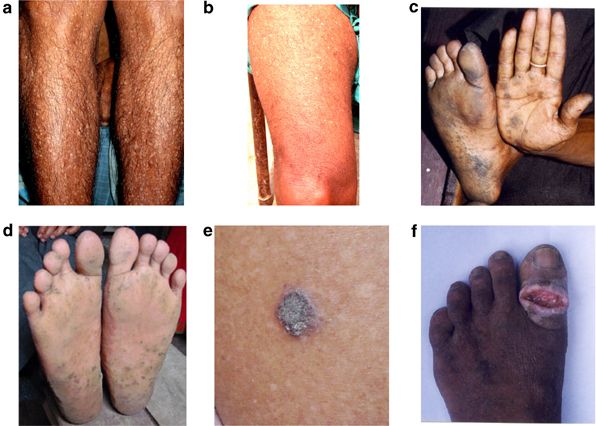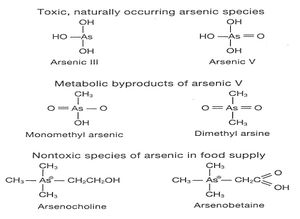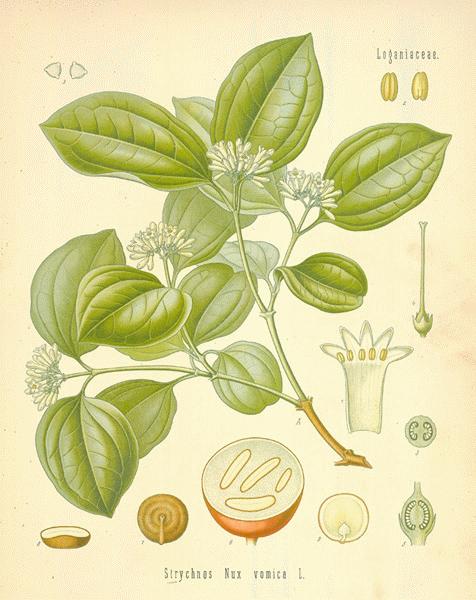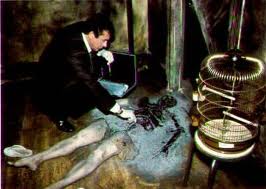Arsenic Poisoning

 Arsenic itself is not poisonous; it is the compounds of arsenic, particularly arsenous oxide or arsenic trioxide (sankhya or somalkhar) and various arsenites of Cu, Na and K that are toxic to the humans. Arsenic trioxide is a component of fruit sprays, weed-killers, dyeing agents, insecticides, rat poisons, etc. and also a medical preparation called Fowler’s solution (used in past for Leukemia treatment). It is a colorless, odorless and almost tasteless compound occuring commercialy as a white powder or in cake, which is at first translucent, but afterwards becomes opaque. Arsenophagists take arsenic daily as tonic or aphrodisiac and acquire tolerance upto 0.3 gm or more in one dose.
Arsenic itself is not poisonous; it is the compounds of arsenic, particularly arsenous oxide or arsenic trioxide (sankhya or somalkhar) and various arsenites of Cu, Na and K that are toxic to the humans. Arsenic trioxide is a component of fruit sprays, weed-killers, dyeing agents, insecticides, rat poisons, etc. and also a medical preparation called Fowler’s solution (used in past for Leukemia treatment). It is a colorless, odorless and almost tasteless compound occuring commercialy as a white powder or in cake, which is at first translucent, but afterwards becomes opaque. Arsenophagists take arsenic daily as tonic or aphrodisiac and acquire tolerance upto 0.3 gm or more in one dose.
A. Mechanism of action and Toxicokinetics:
- Half life of about 2 hours
- Well absorbed dermally, from gut, respiratory tract and parenterally
- Combines with sulfhydryl groups of mitochondrial enzymes and prevents cellular respiration.
- Vascular endothelium is particularly susceptible to the toxic effects.
- Once ingested, arsenic is stored for long periods in certain tissues like bone (replaces phosphorous of bone) and remains permanently in hair, skin and nails (sulphur containing keratin) until shed. Within 30 hours of ingestion, arsenic deposits in the hair. Arsenic levels in the hair sections may provide an indication of the time of exposure based on length from growth site. Persons who died 6 to 8 hours after ingestion of an arsenic overdose, generally do not show arsenic in their hair.
B. Fatal dose: 0.1 to 0.2 gm arsenic trioxide
C. Fatal period: 1 to 2 days
D. Clinical features:
1) Acute poisoning: Acute poisoning is usually suicidal or homicidal. 2 types of acute poisoning are present:
- Fulminant type: Massive dose (3-5 gm) when rapidly absorbed causes shock and circulatory failure without the symptoms of gastroenteritis.
- Gastroenteric form: Initially, there is burning sensation and sweetish metallic taste in mouth. After an interval, signs of gastroenteritis resembling cholera appear. This leads to thirst, oliguria, collapse, cramps, convulsions, heart failure and death. Arsenic poisoning can be differentiated from cholera as follows:
Trait Arsenic Poisoning Cholera Throat pain Before vomiting After vomiting Vomitus With mucus, blood and bile Watery and without mucus, blood or bile Purging After vomiting Before vomiting Tenesmus & anal irritation Present Absent Voice Unaffected Rough and whistling Conjunctiva Inflamed Not inflamed Stool lab Arsenic Vibrio cholera - Narcotic form: Slight gastrointestinal symptoms
2. Chronic poisoning: It is usually accidental and environmental (eg. groundwater exposure).
- Classic state of ill health often attributed incorrectly to natural illness.
- Non-specific features: Loss of appetite, nausea, vomiting, jaundice, weight loss and anemia
- Specific features:
- Hyperkeratosis of palms and soles
- Rain drop pigmentation of general skin surface with patches of leukoplakia
- Loss of hair
- Transverse white “Aldrich-Mees” line on nails
- Peripheral neuritis with itching, tingling and paresthesia of extremities with painful swelling (erythromelalgia)
- Increased risk of cancer: bladder, kidney, liver, lung
E. Diagnosis:
- X-ray abdomen: may reveal ingested radio-opaque arsenic
- Serum arsenic (only detectable during 1st 2-4 hrs of exposure): may be >7mg/dl
- 24 hr urinary arsenic (after 48 hrs abstinence from sea food which can raise urinary arsenic): >50mg/day
- Arsenic in hair and nails
- Abnormal LFTs
- Hematology: Anemia, Leukocytosis
- Urine: Hematuria, Proteinuria
- ECG: QRS complex broadening, QT prolongation, ST-segment depression, T wave flattening and multifocal ventricular tachycardia
F. Treatment of Acute Poisoning
- The stomach-pump, emetics, then milk, milk and eggs, oil and lime-water.
- Inflammatory symptoms, collapse, coma, etc., must be treated on ordinary principles.
- Antidote: Hydrated sesquioxide of iron (forms sparingly soluble ferric arsenate), Colloidal iron hydroxide, Dialyzed iron in large quantities is efficacious.
G. Autopsy:
1. Acute poisoning:
- External examination: Signs of dehydration
- Internal examination:
- Hemorrhagic gastritis (red velvety mucosa)
- Pseudomembrane formation in small intestine
- Subendocardial hemorrhage (nonspecific and can be found in any death resulting from fall in blood pressure or shock)
- Congested internal organs
- Nephritis

b. Raindrop pigmentation on right leg
c. Hyperkeratosis of palm and sole
d. Spotty hyperkeratosis on soles
e. Bowen’s disease on anterior abdominal wall
f. Squamous cell carcinoma on toe of left foot
2. Chronic poisoning:
- External examination:
- Non-specific: Wasting, atrophy, dehydration
- Specific: Skin thickening, hair loss, puffiness of face
- Internal examination:
- Chronic gastritis: excess mucus and patchy mucosal erosion and edema
- Liver: fatty degeneration or necrosis
- Kidney: Renal tubual necrosis
- Heart: Myocardial necrosis
H. Exhumation
Because of the possibility of natural exposure to arsenic, control samples from grave and grave water should be taken during exhumation.
I. Detection
- Extraction: The contents of the stomach, or the solid organs minced up, should be boiled with pure hydrochloric acid and water, then filtered. The filtrate can then be subjected to Reinsch’s process.
- Reinsch’s process: Boil distilled water with one-sixth or one-eighth of hydrochloric acid, and introduce a slip of bright copper. If, after a quarter of an hour’s boiling, there is no stain on the copper, add the suspected liquid. If arsenic be present, it will form an iron-grey deposit. If this foil be dried, cut up, put in a reduction-tube, and heated, crystals of arsenious trioxide will be deposited on the cold part of the tube.
J. Summary of Arsenic poisoning:
Mnemonic: HARMFul CRASH
- Hemmorhagic spots in mucosa
- Addison like disease
- Raindrop pigmentation
- Mees lines on nail
- Fatal dose: 0.2 to 0.3 gm
- Cholera like diarrhea
- Red velvety stomach mucosa
- Arsenic neuritis
- Subendothelial petechial hemorrhages
- Hyperkeratosis of palms and soles





1 Comment
WHY ALL TYPES OF POISONS ARE AVAILABLE IN MARKETS?
Comments are closed.